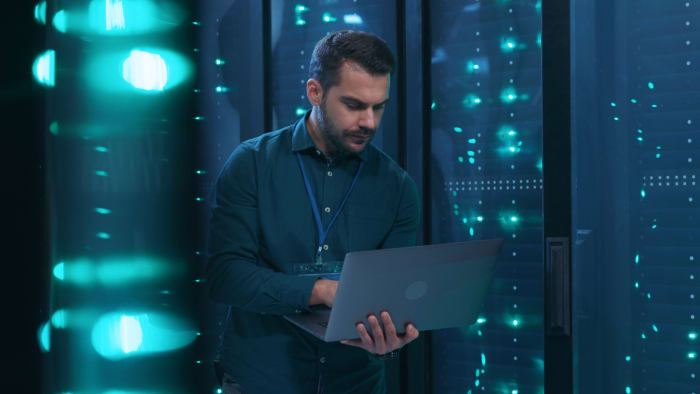Single-Tenant vs Multi-Tenant Apps: Which Architecture is more suitable?


What are the main differences and which system would suit your project better?
When clients hire a software development company, they need the assistance of specialists to figure out how their software should be built. Everyone is looking for cost-effective ways to create a reliable and highly-functional application. That is why clients should decide what architecture will be the basis for their product.
There are two cloud architectures: single-tenant and multi-tenant. Each of them includes its own pros and cons, its own particularities. Which one will fit your project better depends on your specific needs. In our article, we will explain what single-tenant systems and multi-tenant systems mean, identify their differences, and when they are used. We shall also provide some examples of projects Go Wombat created.
What Is Single-Tenant Architecture?
Single tenancy means a single-tenant cloud architecture used only by users of one client. When a single tenant (a customer) is served by one software instance and its infrastructure, all information is stored on separate servers and entirely independent of any other clients.
For example, we can compare the single-tenant environment with a street where several houses are located. Each home has its own independent heating system, so if a system in one house is broken, it won’t affect the other systems in the neighbourhood.
A single-tenant model is often used during developing Software-as-a-Service (SaaS) apps. However, it is evident that installing an independent heating system may be much more expensive than using a centralised heating system.
What Is Multi-Tenant Architecture?
In turn, multi-tenancy is a fundamental technology used by a cloud service that implements large-scale cost and cloud security with the help of hardware and software sharing. Multi-tenant cloud architecture provides direct and secure use of IT resources between a few apps and multiple users.
Thus, it is a more cost-effective architecture since it allows for more efficient resource usage. However, it bears more risks for data security since the isolation level is lower.
A multi-tenancy separates the processes of tenants and makes them independent from each other, both on companies’ and individual users’ levels. There are multi-tenant environments for each business service of a customer. The service has its unique identifier that distributes information between users. The microservice architecture allocates resources required for stable functionality for each business process.
A multi-tenant architecture enables functions control at the user level. That is, it is possible to enable/disable additional properties for each user or group.
Create software with relevant architecture together with Go Wombat — contact us!
Pros And Cons Of Single-Tenant Apps
So, let’s discuss each architecture's benefits and drawbacks. We will start with a single tenancy and its pros.
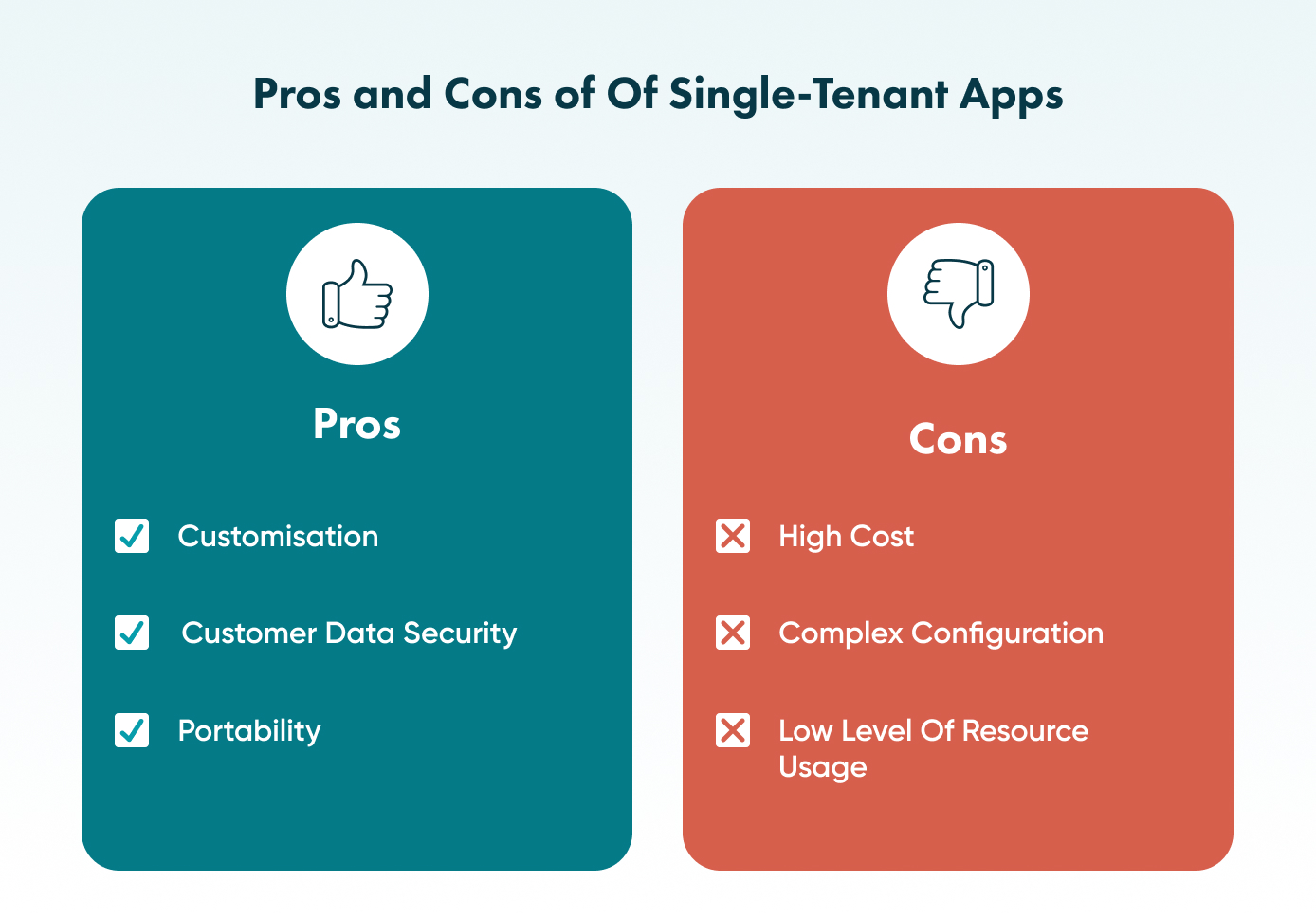
Customisation
In single-tenant applications, more customisation options are available than in multi-tenant architectures. It is connected with dedicated infrastructure for each customer.
Customer Data Security
Isolation of personal data leads to the minimisation of data breach risks, so all sensitive information is appropriately protected. As a result, the level of security in single-tenant architecture can be much higher.
Portability
Data migration can also be a more straightforward process from a single-tenant model. The matter is that multi-tenant environments contain much more data than single-tenant architecture does. Furthermore, there are fewer migration scripts that developers need to write to migrate the data.
However, some cons remain as well:
High Cost
It is more expensive to manage a single-tenant architecture than to work with a multi-tenancy. In addition, managing every customer with separate databases and servers is a more time-consuming process. So management costs can be very high.
Complex Configuration
Instance deployment and database setup are required for each customer, which is a complex and stagnant process. Once the client base starts growing, it becomes more challenging for developers to manage applications.
Low Level Of Resource Usage
The single-tenant model doesn’t allow allocating an equal amount of resources for each customer. Every customer has a different usage pattern, so one customer may use and require more resources, while others will have to settle for less.
Pros And Cons Of Multi-Tenant Apps
Now it is time to discuss some advantages and drawbacks of a multi-tenant architecture. Again, the pros will be the first.
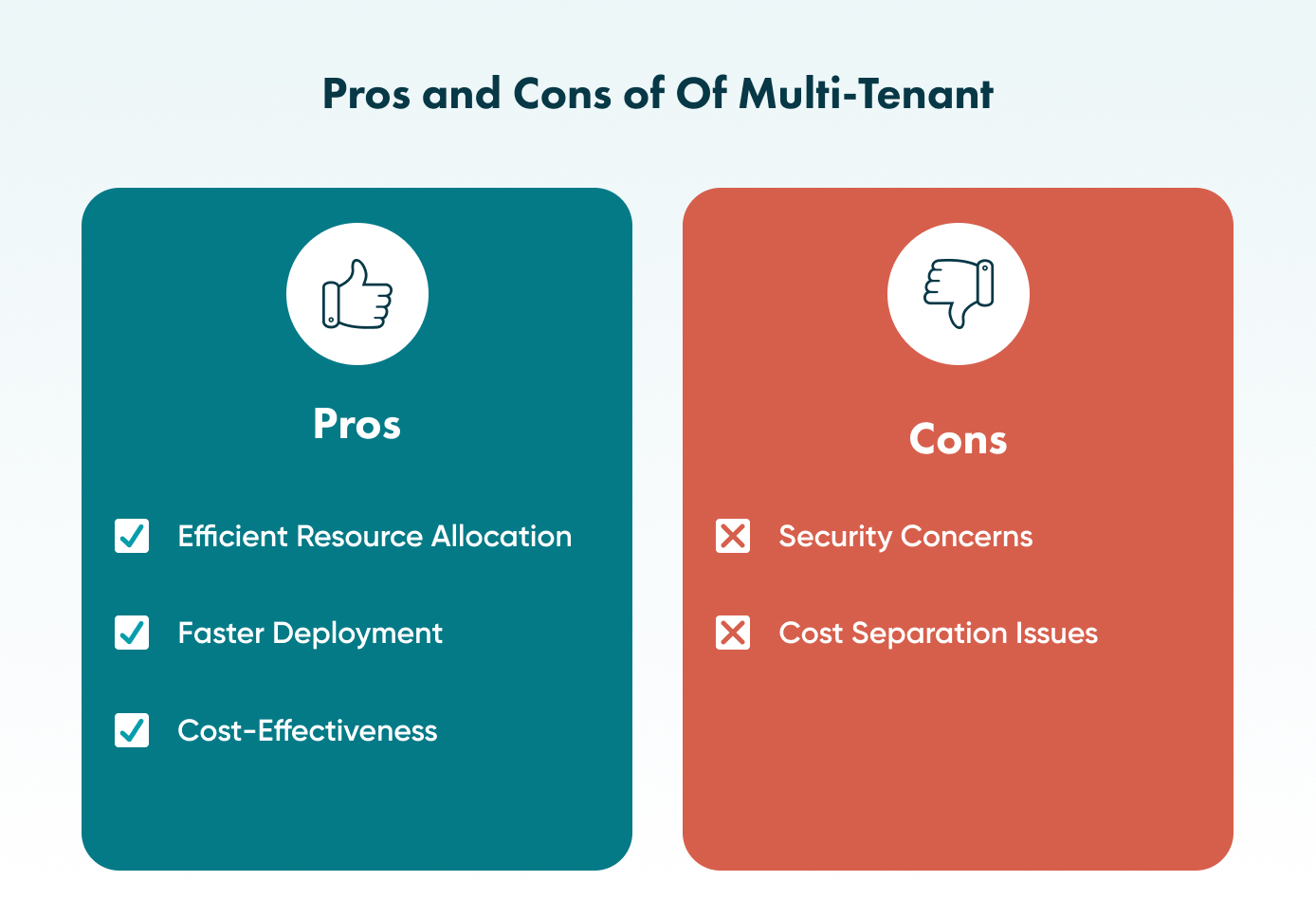
Efficient Resource Allocation
Since there are multiple customers in multi-tenant architectures, all resources are shared between them, and resources will be used with maximum potential.
Faster Deployment
When a startup has a few customers, it will be challenging to provide every customer with a high-quality service using a single-tenant approach. While multi-tenancy makes the servicing process much more accessible, developers can create your multi-tenant application faster using AWS tools or tools of other cloud service providers.
Cost-Effectiveness
Sharing costs between customers in one environment makes app development and maintenance cheaper. So multi-tenant app development can be created at an affordable cost.
As for the cons, they are the following:
Security Concerns
As resources are shared between customers, security risks become higher. The matter is that if there is a data breach on the side of one customer, it may affect other customers since there is no isolation like in single-tenancy.
Cost Separation Issues
Also, as single-tenancy provides customers with its own database, it is easier to separate costs. While a multi-tenant environment complicates this process, cost separation becomes another problem for business owners.
How to choose a suitable architecture for your future app? Go Wombat will provide detailed consulting, get in touch with us!
When To Use Multi-Tenancy And Single-Tenancy
For a start, we need to mention that single tenancy is the right option for the industry where strong privacy is required. The financial and healthcare sectors are good examples.
If you create a healthcare application for the US region, it must comply with HIPAA requirements. Also, the app that stores or processes any personal data in the EU must comply with the GDPR. We have a relevant article about GDPR and HIPAA certification, and we recommend you read it.
In turn, the consumer-facing software application should be built using multi-tenancy. Cloud providers like AWS are frequently used with such apps, so multi-tenancy suits better here.
Single-Tenancy Use Cases
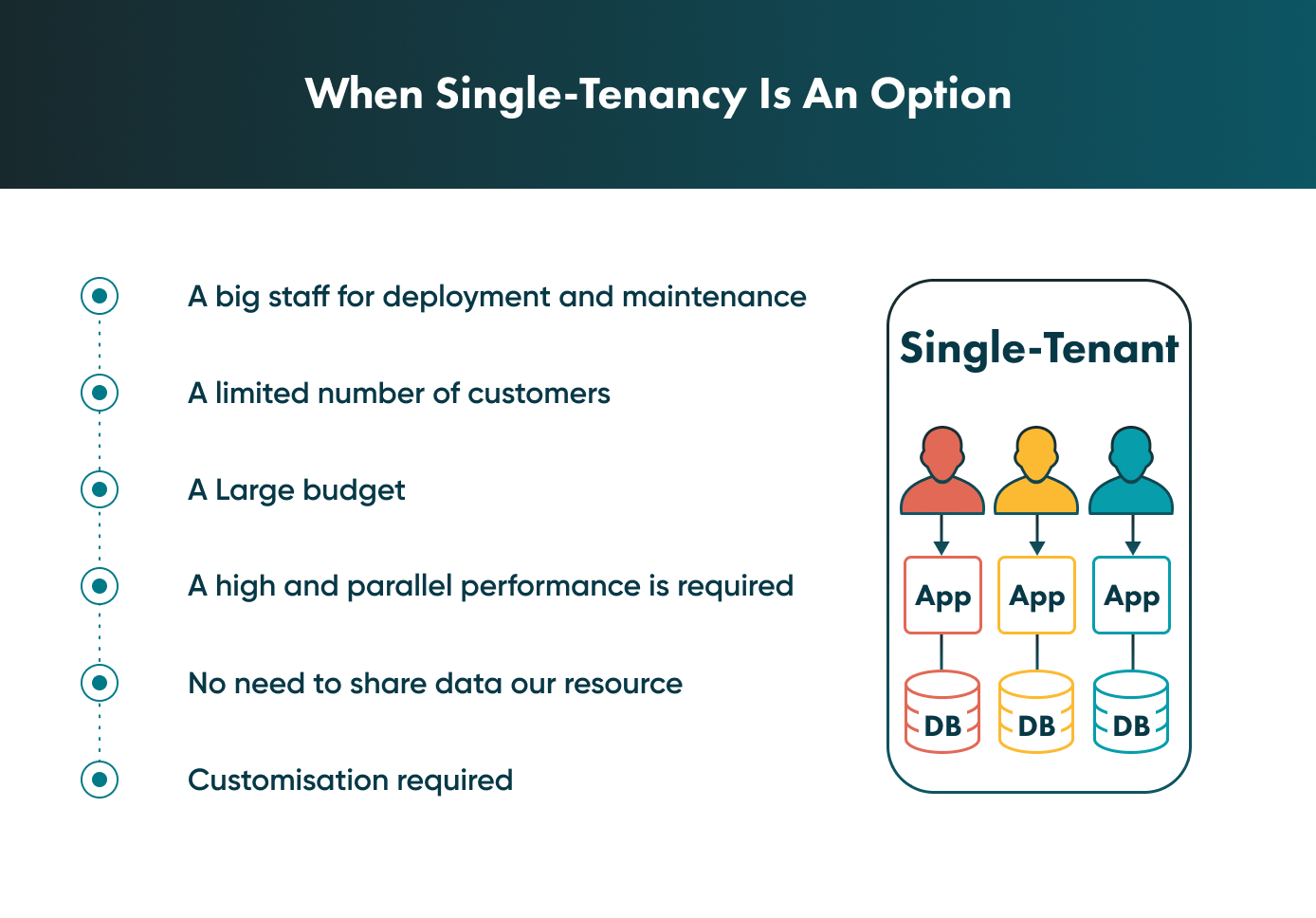
First, if you create an app, single-tenancy will be the right option if:
Your staff is big enough to deploy, maintain, and support everything;
You don’t have many customers;
Your budget is not limited;
You plan to provide high and unparalleled performance;
If you buy an off-the-shelf application, then the single-tenant model will be appropriate when:
Your company’s policy doesn’t provide for resource or data sharing;
You want to customise your product according to your business needs;
You can afford to pay more for higher performance.
Multi-Tenancy Use Cases
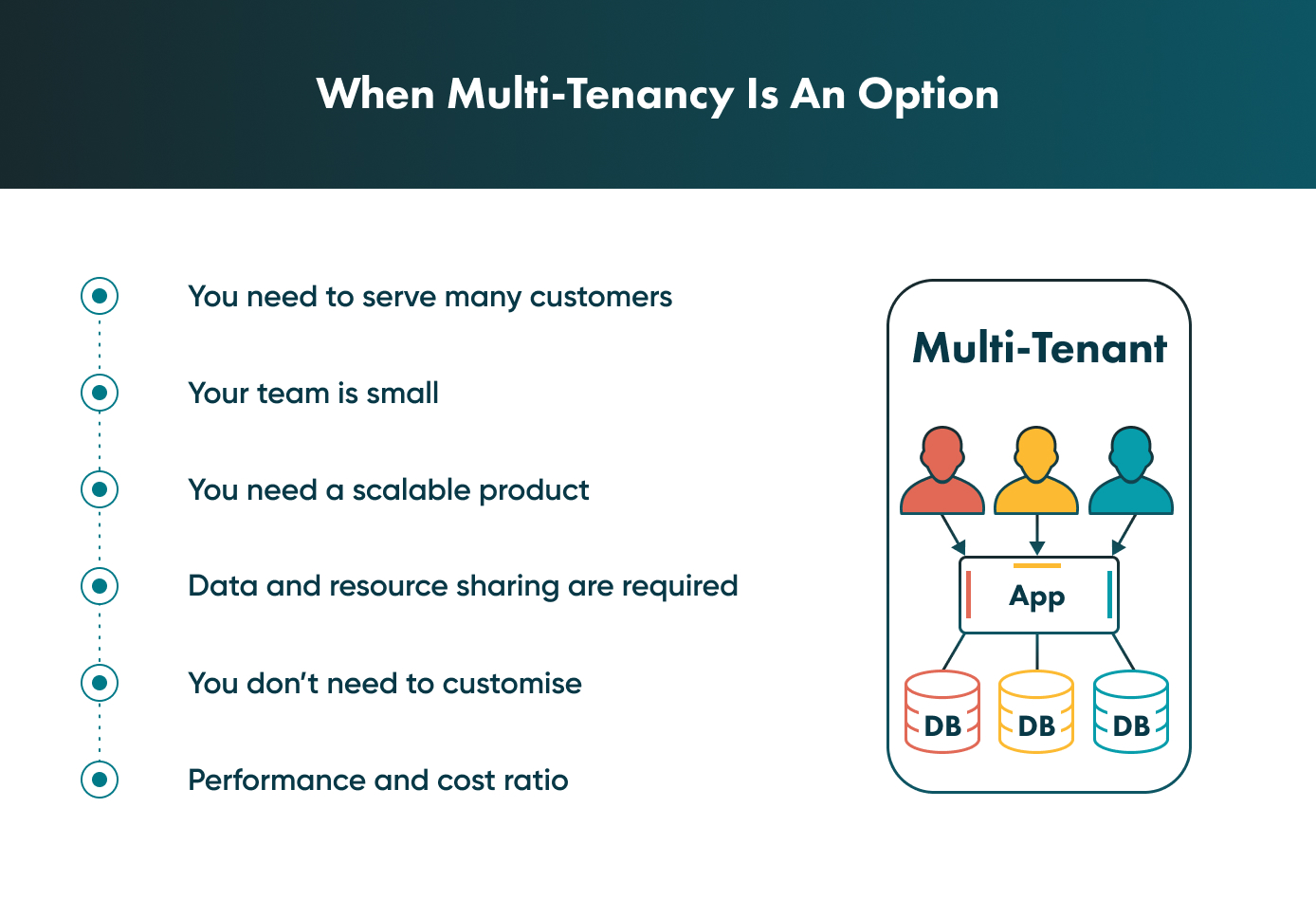
So, if you plan to build an app from scratch, you need to use a multi-tenant approach if:
You want to serve many customers in a relatively cheap cloud environment;
You don’t have a large team to deploy and maintain the product;
You need to have an easily scalable product;
If you buy software, you need multi-tenancy if:
Your company needs data and resource sharing;
You don’t need to customise software and change its configuration substantially;
You want to find a golden mean between performance and cost.
How Go Wombat Works With Multi- and Single-Tenancy
On the whole, most projects we create at Go Wombat are single-tenant. Characteristics of these projects require total isolation, so single-tenant applications prevail in our portfolio. However, multi-tenant apps are also created by our developers.
Multi-tenant Project
A multi-tenant app is a good option for the B2B sector. A good example Go Wombat worked on is the travel service, which allows travellers to book a city trip together with accommodation, local transport and unique activities. In addition, travel websites can use the service to offer different travel options by merging with other suppliers. Travel websites can put together a complete package holiday.
Thus, multi-tenancy means that this project provides different travel agencies with services — they have access to the common databases with travel and associated packages. Still, payments and other personal details will be individual and separated from different tenants.
Single-tenant Project
For example, we can show a couple of single-tenant projects we worked on.
One such project is a product for the HR department, a web-based service that allows users to create surveys and select the recipient. The service helps companies develop surveys for employees to identify their preferences, what they are satisfied with (or not), and other helpful feedback. Charts and diagrams are created based on results, and it is possible to assess all indicators. The product is made only for a specific company and has a single-tenant, isolated structure.
Another example is the rental management system that allows customers to book online, quickly ensuring paid reservations for a company. A web service allows for managing all the bookings, upcoming orders, equipment availability, and creating reports. Again, guests can book and pay online for the service. The service is also used by only one customer.
Unlock Success with Premium Software Development
Contact us


Which One Should You Choose: Single-Tenant vs Multi-Tenant?
Even though both architectures have benefits and drawbacks, multi-tenancy can be a better choice in most cases. When qualified specialists do everything right, it provides a more efficient resource usage platform and can be easily maintained.
Furthermore, a multi-tenant SaaS architecture is cloud-based software. Many cloud platforms are built using multi-tenant architectures, which adapt quickly to support multiple customers.
However, if your company follows strict guidelines and operates in the healthcare or financial sectors, a single-tenant approach will be preferable for your software.
If you are still hesitating and don’t know what architecture fits your project better, Go Wombat will assist you and pick the right technology stack for any project. Our task is to make your software reliable and attractive.
Create a multi-tenant or single-tenant application with Go Wombat — contact us!
How can we help you ?





